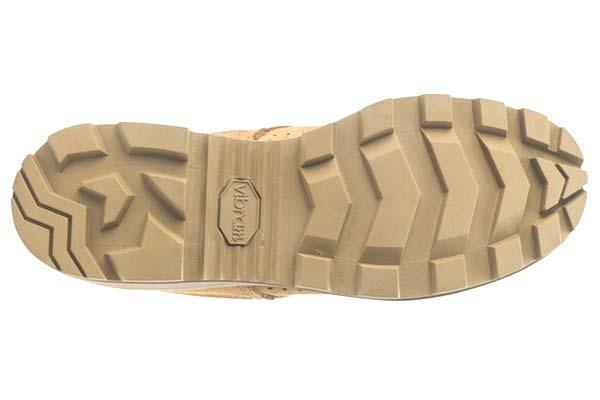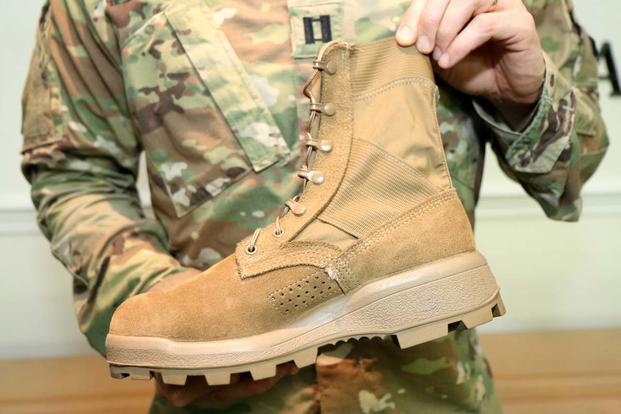The U.S. Army will soon outfit two brigades of soldiers with a new Jungle Combat Boot billed as more comfortable, faster drying and puncture resistant than the service's long-retired Vietnam-era jungle boot, equipment officials maintain.
Belleville Boot Company and Rocky Boots were selected in December to supply the Army with about 36,700 pairs of newly-designed Jungle Combat Boots as part of a direct requirement effort to select and field jungle boots to infantry soldiers to wear in the hot, tropical terrain of the Pacific theater.
The Army plans to field the 2nd and 3rd Brigade Combat Teams of the 25th Infantry Division in Hawaii beginning in March
"We are really, really excited about the jungle boot program," Lt. Col. John Bryan, the product manager for Soldier Clothing and Individual Equipment at Fort Belvoir, Virginia, said during an interview with reporters at the base.
"This is important to the Army. It's important to soldiers in a hot, high-humidity, high moisture area, and we are responding as quickly as we possibly can with the best available, immediate capability we can get on soldiers feet quickly and then refine and improve as we go."
The Army and the Marine Corps retired the popular, Vietnam War-era jungle boots in the mid-2000s when both services transitioned to a desert-style combat boot for combat operations in Iraq and Afghanistan.
The new Jungle Combat Boot looks similar to the Army Hot Weather Boot and feature rough-side out leather and speed laces. But they are radically different than the jungle boots soldiers wore throughout the 1980s and 1990s.
The old jungle boots had no shock-absorbing material, just hard rubber. The new jungle boots feature a thick layer of shock-absorbing polyurethane.
The insert on the new boot is also made of polyurethane with channels and perforations designed to move water away from the foot.
The old jungle boots had two drain holes that often became clogged with mud. The new boots feature several small perforations into the fabric on both sides of the boot that are more effective at pushing water out of the boots, Army officials maintain.
The outer sole is similar to the popular Panama-style tread on the old jungle boot but is designed with a shorter heel so there is less of a chance of it snagging on debris and undergrowth and becoming a trip hazard.
Instead of cotton duck that took a long time to dry out, the new boots feature a specially-treated knit mesh that dries much faster, Army officials say.
"We didn't come up with the boot in the lab … we really dealt very, very closely with what a soldier needs," said Capt. Daniel Ferenczy, assistant product manager for SCIE.
The $4.1 million program included field tests with soldiers from the 25th ID in Hawaii.
Staff Sgt. Joshua Morse, a lead instructor at the Jungle Operations Training Center in Hawaii, was involved in the testing.
Morse recalled being in Brunei, a stretch of jungle in Borneo, and wearing a pair of broken-in Army hot weather boots he had worn in Iraq and Afghanistan.
"I got trench foot within a week," he said.
Then he decided to wear and new pair of the Army's Jungle Combat Boots he had been given to test. He wore them "46 days, soaking wet, non-stop," he said.
"My feet were never completely dry, but I wore those boots and never had a problem with them," Morse said.
"I have worn these boots for a year now, and all the feedback we have given to the companies, they have come back and given us better a product."
The new jungle boots also are designed to protect soldiers from puncture wounds.
Punji sticks, which were a significant threat in the Vietnam War, are still an issue in many jungle environments, Morse said.
The people that live in these jungles still "use these punji pits for hunting purposes," Morse said.
The old jungle boots had a thin metal shim in the sole for puncture protection that made the boots get too hot or too cold depending on the outside temperature, Army officials said.
The new design is made of a thick, puncture-resistant fabric that provides better protection, equipment officials maintain.
The current plan is to field the 25th ID's 2nd BCT beginning in March and finish in June and then field the 3rd BCT from June until September. Each soldier will get two pairs of boots.
Equipment officials will then go back and get more feedback from soldiers to decide if any design changes are need. The Army will then determine which units it will field with the new jungle boots.
"These are really, really close to what the final boot design is going to be," Bryan said. "The best testing is letting soldiers do what soldiers do. Having these two brigades wear these boots for over a year period is going to give us all the information we could ever hope to get … because they wear them hard."
-- Matthew Cox can be reached at matthew.cox@military.com.



























